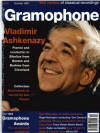Texte paru dans: / Appeared in:
*

GRAMOPHONE (10/1993)
Pour s'abonner /
Subscription information
Alia Vox
AVSA9867

Code-barres / Barcode:
7619986398679
Reviewer: Tess Knighton
In many ways I think it is one of Hesperion’s most successful (and certainly one of the most striking) contributions to the sixteenth-century Hispanic repertory. Recorded by the male voices of Capella Reial witth support from viols, sackbuts, organ and dulcian, it inhabits a sound world that contrasts strongly with any of their other recordings, including the Guerrero disc where the instrumentation is more varied and the vocal sonority often dominated by the distinctive (and distinguished) soprano of Montserrat Figueras. The scoring adopted on the Morales disc (for which incidentally, there is no firm evidence) is mournful, even lugubrious, but it suits the mood of the music so well that the overall effect, enhanced by a reverberant church acoustic, is of a lustrous velvet unremittingly black but with a rich sheen that catches the light of the musical textures. Most of the music for the Office of the Dead survives in only one source, preserved in Puebla Cathedral, Mexico. The setting is of such stark simplicity really a chordal rendition of the chant that the attribution to Morales, one of the great contapuntalists of his day, must be questionable, unless it was deliberately composed in this manner for performance in the New World (an undocumented but fascinating possibility). Circumstantial evidence in the form of a detailed account of the solemn funeral rites held in Mexico City in honour of Charles V in November 1559 which mentions polyphonie settings of some of these texts by Morales, and the occasional harmonic shift and cadential pattern that seem to bear his stylistic imprint, provide some support in favour of the attribution. Ultimately, however, the Requiem Mass is the more satisfying piece, although conforming to an indigenous tradition of setting texts of this kind, it, too, is less concerned with contrapuntal skill and more with a sustained solemnity that has earned Spanish polyphony of this period the epithets ‘austere’ and ‘mystical’. In one sense it is a shame that Hesperion XX chose to represent Morales in this way: his qualities as a composer of non-funeral music are yet to be widely appreciated. Nevertheless, this disc is so special in the sound of male voices doubled by those mellow and largely unobtrusive instruments and above all, the atmosphere of the recording (it has the feel of the early hours of the morning about it) that I would say it is one of the best they have ever made.
The Guerrero disc is altogether another story. The blend and unanimity of tone colour achieved on the Morales disc is instantly dispelled here by the addition of the sopranos, who sing in a quite different way, and while the participation of instruments is much more easily justified in this later motet repertory of Seville Cathedral, the overall effect is not consistently successful. Something of the richness of the sonority of the Morales disc is found in the full-textured O sacrum convivium and some of the polychoral items like the terrifically exciting 12-voice Duo Serapahim work well, but too often the combination of voices and instruments serves only to muddy the contrapuntal texture and obscure the words. The instrumental playing is, as always with Hesperion XX, superb, and the purely instrumental items are among the most compelling on the disc. Savall and his team have to be congratulated for attempting to perform Guerrero’s music in this way, but this recording must represent an experimental stage in which not every piece finds its best mode of expression (the eight-voice Pater Noster is an example) as almost every possible combination of voices and instruments is tried out (even within the course of one piece in the case of the Salve regina). Further research into this area is desperately needed: did instruments consistently double or substitute voices? Did the ensemble of sackbuts and cornetts (paid as a separate body by the cathedral chapter) mingle with viols as here? Did instruments participate only in certain kinds of pieces? Was there a correlation between style and instrumentation (Savall’s recording tends to suggest that there was although I’m not sure that this was his intention)? What influence did his visits to Venice have on Guerrero? How and in what contexts was ornamentation used (it adds brilliance to the instrumental version of O altitudo divitiarum here)? It would have been interesting to know the rationale behind Savall’s decisions. Questions of scoring aside, on one point there is absolutely no doubt: the quality of Guerrero’s music and this is a fine selection of his pieces (though with perhaps too much overlap with existing recordings). Both these recordings deserve a place in your collection: the Guerrero because it is a bold attempt to tackle an almost unstudied question of performance practice, and the Morales because, quite simply, it is so special.
Cliquez l'un ou l'autre
bouton pour découvrir bien d'autres critiques de CD
Click either button for many other reviews


